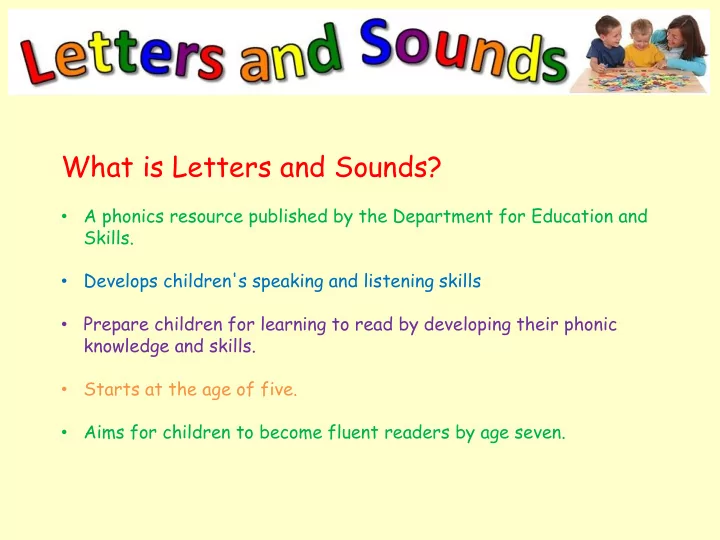

What is Letters and Sounds? A phonics resource published by the Department for Education and • Skills. Develops children's speaking and listening skills • Prepare children for learning to read by developing their phonic • knowledge and skills. Starts at the age of five. • Aims for children to become fluent readers by age seven. •
Work Shops 10 minutes Excerpt from a Jolly Phonics Video. Jolly Phonics • Actions Kinaesthetic ways to learn. • Kelly – YR Teacher Hand out to take away and practise at home. • Letters and The phases – how long are they and in which years are • sounds. they taught? Which phonemes are taught in which phase? • Clare – Inclusion The KS1 Phonics test. • Leader Segmenting and How to segment. • Blending How to blend. • What makes a ‘tricky word’ tricky? • Ruth – specialist TA
Phase Phonic Knowledge and Skills Phase One Activities are divided into seven aspects, including environmental sounds, instrumental sounds, body sounds, (Nursery/Reception) rhythm and rhyme, alliteration, voice sounds and finally oral blending and segmenting. Phase Two Learning 19 letters of the alphabet and one sound for each. (Reception) up to Blending sounds together to make words. Segmenting 6 weeks words into their separate sounds. Beginning to read simple captions. Phase Three The remaining 7 letters of the alphabet, one sound for (Reception) up to each. Graphemes such as ch, oo, th representing the 12 weeks remaining phonemes not covered by single letters. Reading captions, sentences and questions. On completion of this phase, children will have learnt the "simple code", i.e. one grapheme for each phoneme in the English language.
Phase Phonic Knowledge and Skills Phase Four No new grapheme-phoneme correspondences are taught in (Reception) 4 to 6 this phase. Children learn to blend and segment longer weeks words with adjacent consonants, e.g. swim, clap, jump. Phase Five Now we move on to the "complex code". Children learn more (Throughout Year graphemes for the phonemes which they already know, plus 1) different ways of pronouncing the graphemes they already know. Phase Six Working on spelling, including prefixes and suffixes, (Throughout Year 2 and beyond)
Phase 2 Set 1: s, a, t, p Set 2: i, n, m, d four new letters. sound out new words, as they are learned e.g. an, in , nip, pan, pin, tin, tan, nap Set 3: g, o, c, k four new letters, 28 new decodable including kid, kit, Kim, Ken four high frequency words Set 4: ck, e, u, r four new graphemes, with 36 new decodable words • two syllables words • two "tricky words": the and to • Set 5: h, b, f, ff, l, ll, ss introduces seven graphemes (three of which are doubled letters) • 69 new decodable words e.g. lap, let, leg, lot, lit, bell, fill, doll, tell, sell, Bill, • Nell, dull, laptop "tricky" words: no, go and I. •
Phase 3 Set 6: j, v, w, x Set 7: y, z, zz, qu Consonant digraphs: ch, sh, th, ng Vowel digraphs: ai, ee, igh, oa, oo, ar, or, ur, ow, oi, ear, air, ure, er Tricky words During Phase 3, the following tricky words (which can't yet be decoded) are introduced: he she we me be was you they all are my her
Phase 5
Glossary Phoneme - The smallest unit of sound. There are approximately 44 phonemes in • English (it depends on different accents). Phonemes can be put together to make words. Grapheme - A way of writing down a phoneme. Graphemes can be made up from 1 • letter e.g. p, 2 letters e.g. sh, 3 letters e.g. tch or 4 letters e.g ough. GPC - This is short for Grapheme Phoneme Correspondence. Knowing a GPC means • being able to match a phoneme to a grapheme and vice versa. Digraph - A grapheme containing two letters that makes just one sound (phoneme). • Trigraph - A grapheme containing three letters that makes just one sound (phoneme). • Oral Blending - This involves hearing phonemes and being able to merge them • together to make a word. Children need to develop this skill before they will be able to blend written words. Blending - This involves looking at a written word, looking at each grapheme and using • knowledge of GPCs to work out which phoneme each grapheme represents and then merging these phonemes together to make a word. This is the basis of reading. Oral Segmenting - This is the act hearing a whole word and then splitting it up into • the phonemes that make it. Children need to develop this skill before they will be able to segment words to spell them. Segmenting - This involves hearing a word, splitting it up into the phonemes that make • it, using knowledge of GPCs to work out which graphemes represent those phonemes and then writing those graphemes down in the right order. This is the basis of spelling.
Actions
Recommend
More recommend